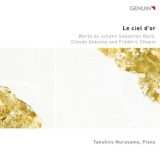Takuhiro Murayama beginnt sein Programm mit Bachs Französischer Suite Nr. 3 auf sehr intelligente Weise, und obwohl er das Tänzerische nicht in den Mittelpunkt stellt, ist er doch so freigiebig mit Effekten, dass die angenehm flüssige Musik allemal attraktiv bleibt.
Der Begriff Images bei Claude Debussy steht für den Wunsch, mit den traditionellen Mustern der Musik des 19. Jahrhunderts zu brechen. Wie sehr seine Klaviermusik auf der Suche nach neuen Klängen ist, unterstreicht Takuhiro Murayama in seiner Interpretation des zweiten Bandes dieser Images. Mit seiner hervorragenden Technik bildet er die Leichtigkeit von Debussys Klangwelt nach, ohne Farbeffekte zu übertreiben. Das lässt die Stücke sehr modern werden.
Abschließend spielt der Japaner Chopins dritte Sonate. Der Beginn ist sehr lyrisch und schwärmerisch, das Scherzo ungemein leicht und verspielt, im Gegensatz zum fast stockenden Largo. Im Finale haben andere Pianisten viel mehr Energie benutzt. Murayama wirkt eher zurückhaltend, wie mit eingelegter Bremse, ehe die Coda dann sehr verspielt und brillant wird.
Und so haben wir es denn hier mit sehr persönlichen Interpretationen zu tun, die durchaus interessant sind.
Takuhiro Murayama begins his program with Bach’s French Suite No. 3 in a very intelligent way, and although he does not focus on the dance character, he is so generous with effects that the pleasantly fluid music remains attractive at all times.
The term Images in Claude Debussy’s music stands for the desire to break with the traditional patterns of 19th century music. Takuhiro Murayama’s interpretation of the second volume of these Images underlines the extent to which his piano music is in search of new sounds. With his outstanding technique, he recreates the lightness of Debussy’s sound world without exaggerating color effects. This makes the pieces very modern.
Finally, the Japanese composer plays Chopin’s third sonata. The beginning is very lyrical and romantic, the Scherzo incredibly light and playful, in contrast to the almost halting Largo. Other pianists have used much more energy in the finale. Murayama seems rather restrained, as if with the brakes on, before the coda becomes very playful and brilliant.
And so we are dealing here with very personal interpretations that are quite interesting.
























